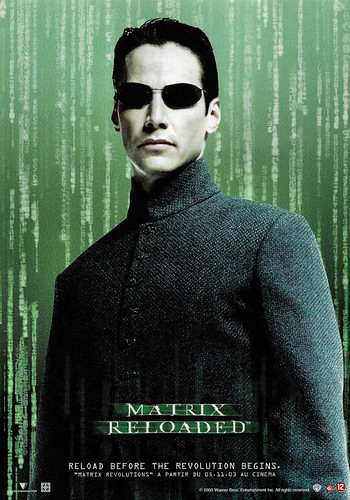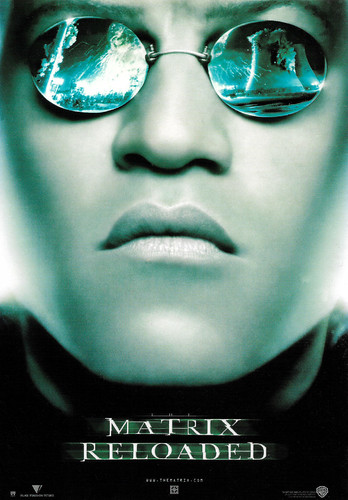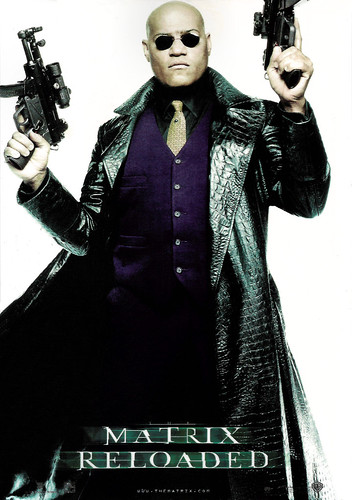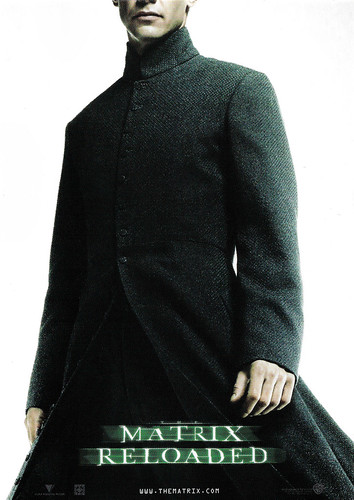
Belgian postcard by Boomerang for Extrazone. Photo: Warner Bros. Keanu Reeves in The Matrix Reloaded (Lana Wachowski, Lilly Wachowski, 2003).

French postcard by Sonis, no. F. 103. Photo: Warner Bros. Monica Bellucci in The Matrix Reloaded (Lana Wachowski, Lilly Wachowski, 2003).

Belgian postcard by Boomerang for Extrazone. Photo: Warner Bros. Carrie Ann Moss in The Matrix Reloaded (Lana Wachowski, Lilly Wachowski, 2003).

Vintage postcard, no. 810. Photo: Warner Bros. Hugo Weaving in The Matrix Reloaded (Lana Wachowski, Lilly Wachowski, 2003).
Extremely difficult action sequences
In the first film of the trilogy, The Matrix (Lana Wachowski, Lilly Wachowski, 1999), Neo (The One - Keanu Reeves) discovered that the life he was leading was not real and found out what The Matrix is. At the end of the 21st century, mankind invented real AI (Artificial intelligence). This technology worked only on solar energy.
When the machines turned against humanity, people thought that by shutting them off from sunlight they could be rendered harmless. The humans turned the sky into an endless black cloud. The machines discovered an alternative form of energy generation: using the body heat of living people. So people were effectively turned into batteries.
To prevent humans from rebelling, the machines created a simulation of the world before it was destroyed and taken over. This virtual world was called "The Matrix" by the rebels. In the second film, The Matrix Reloaded (Lana Wachowski, Lilly Wachowski, 2003), Neo tries to fulfill The Prophecy and with freedom fighters Trinity (Carrie-Anne Moss), and Morpheus (Laurence Fishburne), he continues to lead the revolt against the Machine Army.
They estimate that they have 72 hours until Zion falls under siege to the Machine Army. Only a matter of hours separates the last human enclave on Earth from 250,000 Sentinels programmed to destroy mankind. But the citizens of Zion, emboldened by Morpheus's conviction that the One will fulfill the Oracle's Prophecy and end the war with the Machines, rest all manner of hope and expectation on Neo, who finds himself stalled by disturbing visions as he searches for a course of action.
Neo, Trinity, and Morpheus unleash their arsenal of extraordinary skills and weaponry against the systematic forces of repression and exploitation. Following the success of the previous film, the Wachowskis came up with extremely difficult action sequences, such as the Burly Brawl, a scene in which Neo had to fight 100 Agent Smiths. To develop technologies for the film, Warner Bros. launched ESC Entertainment.

French postcard by Sonis, no. F 110. Photo: Warner Bros. Laurence Fishburne in The Matrix Reloaded (Lana Wachowski, Lilly Wachowski, 2003).

Belgian postcard by Boomerang for Extrazone. Photo: Warner Bros. Laurence Fishburne in The Matrix Reloaded (Lana Wachowski, Lilly Wachowski, 2003). Caption: Reload before the revolution begins.

Dutch postcard by Boomerang Studycards, Amsterdam, no. P08-03, 2003. Laurence Fishburne in The Matrix Reloaded (Lana Wachowski, Lilly Wachowski, 2003).

French postcard by Sonis, no. F 102. Photo: Warner Bros. Laurence Fishburne in The Matrix Reloaded (Lana Wachowski, Lilly Wachowski, 2003).
One of the most genuinely anticipated movies of its time
The Matrix (1999) was a cult hit, but The Matrix Reloaded (2003) made more money. Skyler Miller at AllMovie: "One of the most genuinely anticipated movies of its time, The Matrix Reloaded saturated theaters with an expectation of excellence that few films would ever be able to meet. But even with unrealistic expectations taken into account, this first sequel to The Matrix still disappoints. Respect must be given to the ambition, complexity, and sheer scale of the endeavor, but this quickly gives way to the significant problems with pacing and structure that didn't exist in the first movie."
The Matrix Reloaded (2003) grossed $739.4 million worldwide and received generally positive reviews from critics. Roger Ebert: "in Reloaded, (Neo) destroys dozens of clones of Agent Smith (Hugo Weaving) in martial combat. That fight scene is made with the wonders of digital effects and the choreography of the Hong Kong action director Yuen Wo Ping, who also did the fights in Crouching Tiger, Hidden Dragon. It provides one of the three great set pieces in the movie.
The second comes when Morpheus returns to Zion and addresses the assembled multitude--an audience that looks like a mosh pit crossed with the underground slaves in Metropolis. After his speech, the citizens dance in a percussion-driven frenzy, which is intercut with Neo and Trinity (Carrie-Anne Moss) having sex. I think their real bodies are having the sex, although you can never be sure. The third sensational sequence is a chase involving cars, motorcycles and trailer trucks, with gloriously choreographed moves including leaps into the air as a truck continues to move underneath. That this scene logically takes place in cyberspace does not diminish its thrilling 14-minute fun ride."
The Wachowskis paid a lot of attention to the storyline, there are many philosophical references, and the protagonist of the film, Neo, bears a striking resemblance to Jesus. He fights for 'Zion', sacrifices himself at the end of the trilogy, and fights an enemy far greater than himself.
The Matrix Reloaded and the third film, The Matrix Revolutions (2003) were filmed simultaneously but were released months apart in cinemas for marketing reasons. The initial plan was for the two films to be released two weeks apart, but this was eventually changed to six months. The Matrix Reloaded is absolutely inseparable from The Matrix Revolutions; the story in Reloaded stops abruptly and is continued in Revolutions.

Dutch postcard by Boomerang Studycards, Amsterdam, no. P08-03, 2003. Keanu Reeves in The Matrix Reloaded (Lana Wachowski, Lilly Wachowski, 2003).

Dutch postcard by Boomerang Studycards, Amsterdam, no. P08-03, 2003. Carrie Ann Moss in The Matrix Reloaded (Lana Wachowski, Lilly Wachowski, 2003).

Belgian postcard by Boomerang for Extrazone. Photo: Warner Bros. Hugo Weaving in The Matrix Reloaded (Lana Wachowski, Lilly Wachowski, 2003). Caption: Reload before the revolution begins.

Vintage postcard, no. 813. Photo: Warner Bros. Adrian Rayment and Neil Rayment in The Matrix Reloaded (Lana Wachowski, Lilly Wachowski, 2003).
Sources: Roger Ebert (RogerEbert.com), Skyler Miller (AllMovie), Wikipedia (Dutch and English), and IMDb.
No comments:
Post a Comment